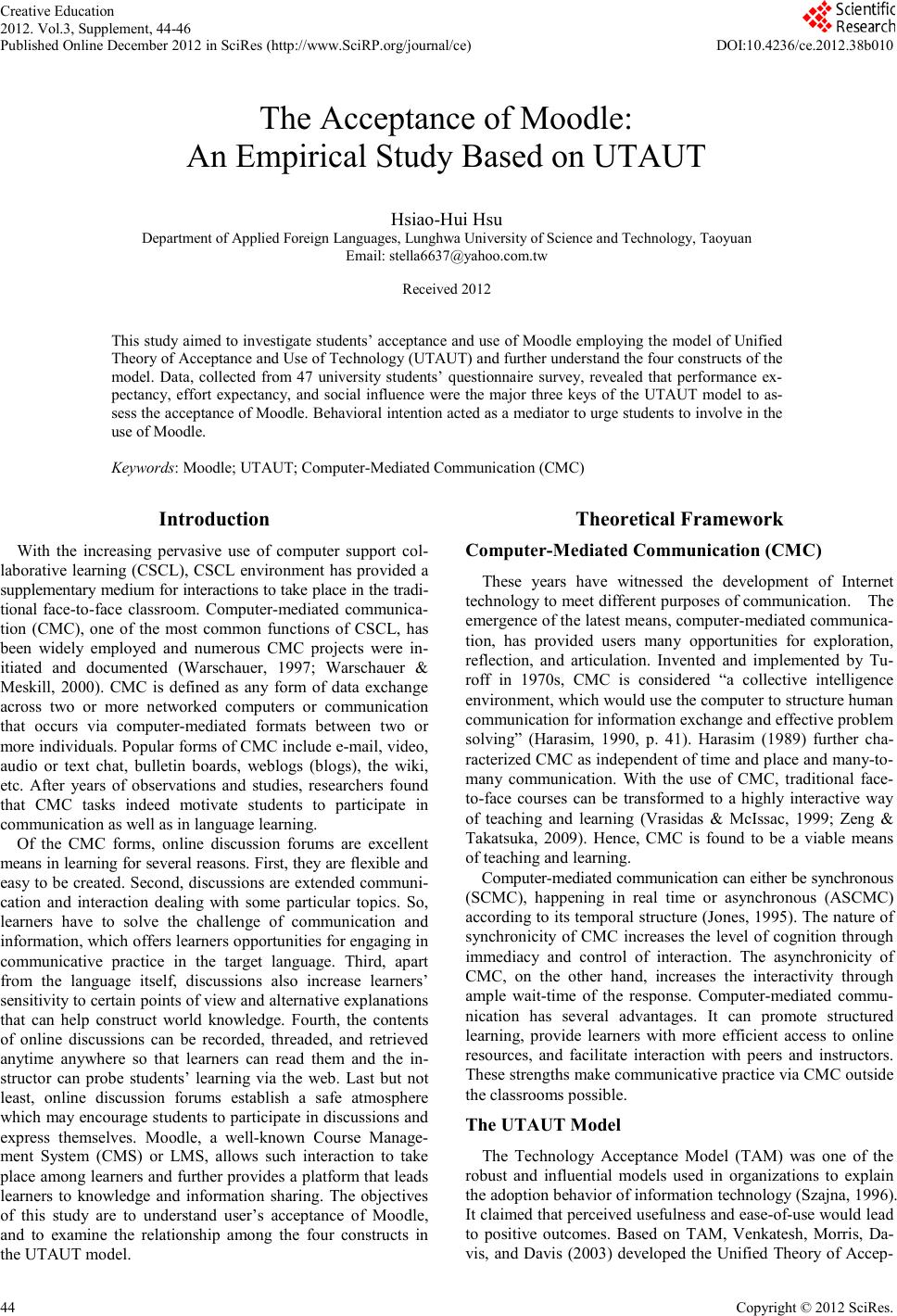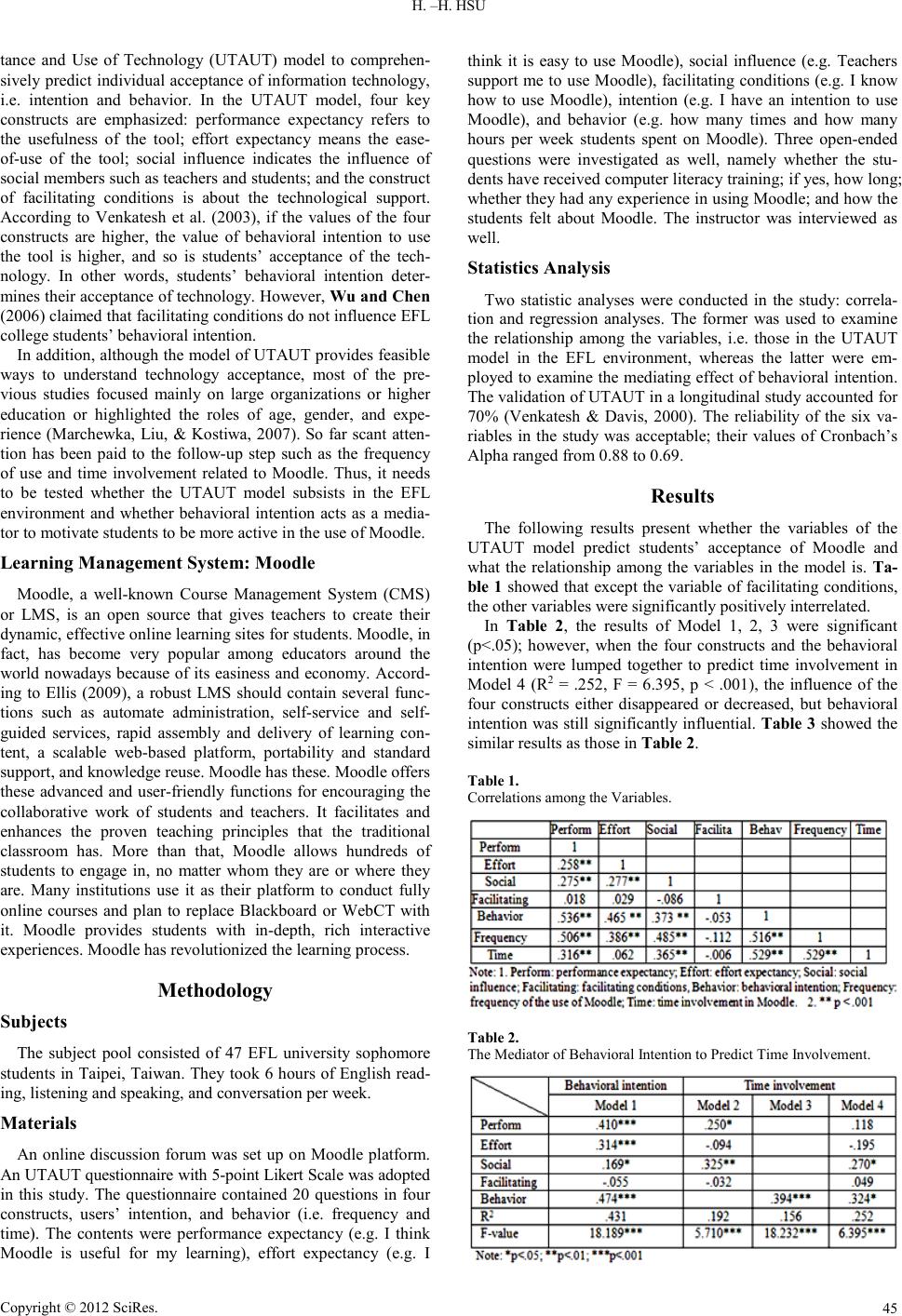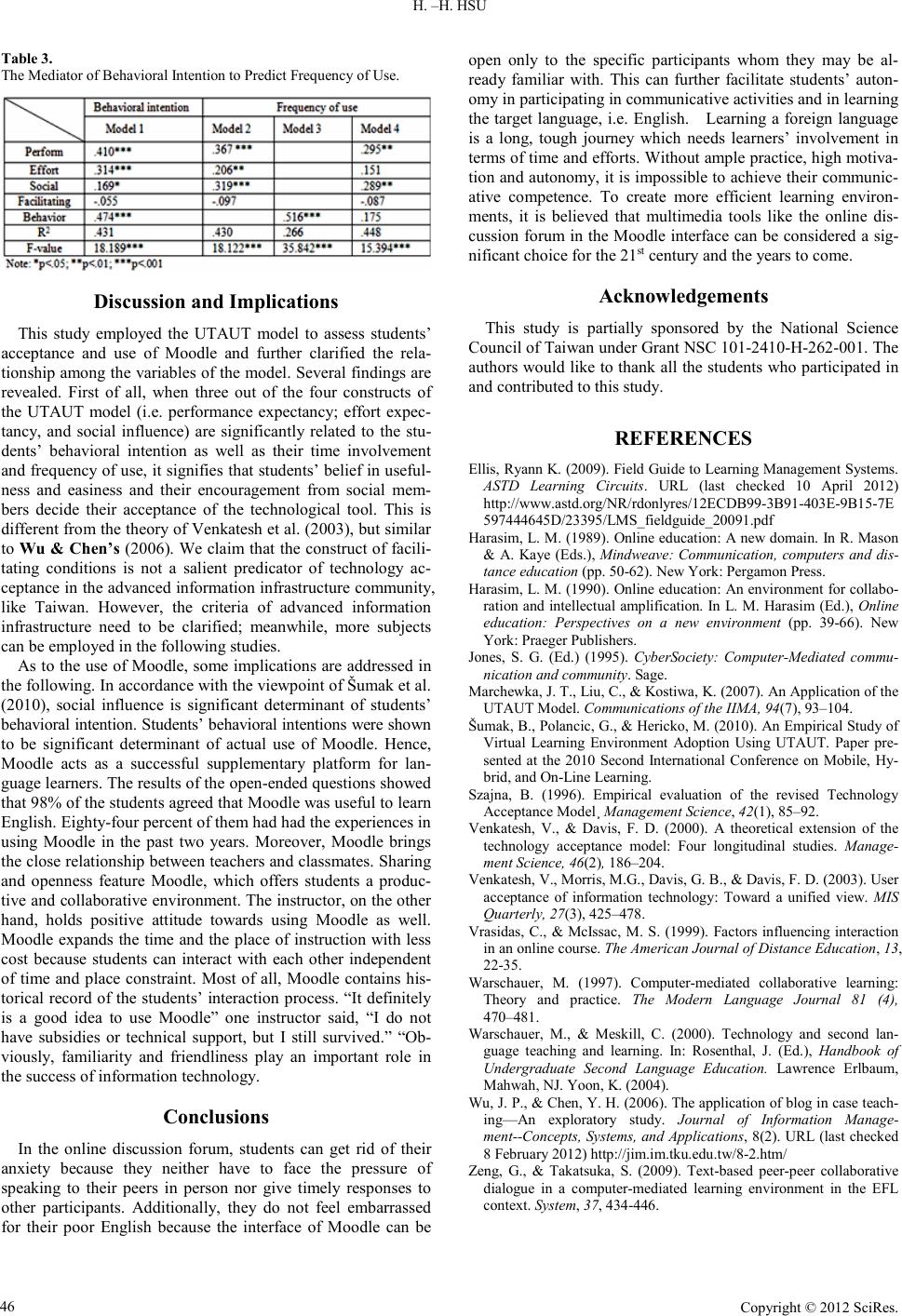Paper Menu >>
Journal Menu >>
 Creat ive Educati on 2012. Vol.3, Supplement, 44-46 Published Online December 2012 in SciRes (http://www.SciRP.org/journal/ ce) DOI:10.4236/ce.2012 .38b010 Copyright © 2012 SciRes. 44 The Acceptance of Moodle: An Empirical Study Based on UTAUT Hsiao-Hui Hsu Department of Applied Foreign Languages, Lunghwa University of Science and Technology, Taoyuan Email: stella6637@yahoo.com.tw Received 20 1 2 This s tudy aime d to inves tigat e students’ acc eptance and us e of Moo dle e mploying t he model of Unifi ed Theor y of Ac c ep tanc e a nd Us e of Tec hnol o gy (UTA U T) a nd f urt her unders t and t he f our c ons tr uc ts of t he model. Data, collected from 47 university students’ questionnaire survey, revealed that performance ex- pectancy, effort expectancy, and social influence were the major three keys of the UTAUT model to as- sess the accep tanc e of Moodle. B ehavior al i ntenti on act ed as a mediat or t o urge student s to i nvolve in t he use of Moodle. Key words: Moodle; UTAUT; Computer-Mediated Communic ation (CMC) Introduction With the increasing pervasive use of computer support col- laborative learning (CSCL), CSCL environment has provided a supp lementary med ium for i nteracti ons to take pl ace in the t radi- tional face-to-face classroom. Computer-mediated communica- tion (CMC), one of the most common functions of CSCL, has been widely employed and numerous CMC projects were in- itiated and documented (Warschauer, 1997; Warschauer & Meskill, 2000). CMC is defined as any form of data exchange across two or more networked computers or communication that occurs via computer-mediated formats between two or more individuals. Popular forms of CMC include e-mail, video, audio or text chat, bulletin boards, weblogs (blogs), the wiki, etc. After years of observations and studies, researchers found that CMC tasks indeed motivate students to participate in communicat ion as well as in language l ear ning. Of the CMC forms, online discussion forums are excellent means in l earnin g for sev eral reas ons. Fir st, they are flexibl e and easy to be cr eated. Seco nd, discussi ons are exten ded communi- cation and interaction dealing with some particular topics. So, learners have to solve the challenge of communication and information, which offers learners opportunities for engaging in communicative practice in the target language. Third, apart from the language itself, discussions also increase learners’ sensitivity to certain points of view and alternative explanations that can help construct world knowledge. Fourth, the contents of online discussions can be recorded, threaded, and retrieved anytime anywhere so that learners can read them and the in- structor can probe students’ learning via the web. Last but not least, online discussion forums establish a safe atmosphere which may enco urage stud ents to par ticipate in d iscussion s and express themselves. Moodle, a well-known Course Manage- ment System (CMS) or LMS, allows such interaction to take place among learners and further provides a platform that leads learners to knowledge and information sharing. The objectives of this study are to understand user’s acceptance of Moodle, and to examine the relationship among the four constructs in the UTAUT model. Theoretica l Frame wo rk Computer -Mediate d C ommunicatio n (CMC) These years have witnessed the development of Internet technology to meet different purposes of communication. The emergence o f the l atest mean s, compu ter-mediated co mmunica- tion, has provided users many opportunities for exploration, reflection, and articulation. Invented and implemented by Tu- roff in 1970s, CMC is considered “a collective intelligence environment, which would use the computer to structure human communication for information exchange and effective problem solving” (Harasim, 1990, p. 41). Harasim (1989) further cha- racterized CMC as in dep endent of time and place an d many-to- many communication. With the use of CMC, traditional face- to-face courses can be transformed to a highly interactive way of teaching and learning (Vrasidas & McIssac, 1999; Zeng & Takatsuka, 2009). Hence, CMC is found to be a viable means of teaching and learning. Computer-mediated co mmunicat io n can eit her be s ynchronous (SCMC), happening in real time or asynchronous (ASCMC) according to its temporal structure (Jones, 1995). The nature of synchronicity of CMC increases the level of cognition through immediacy and control of interaction. The asynchronicity of CMC, on the other hand, increases the interactivity through ample wait-time of the response. Computer-mediated commu- nication has several advantages. It can promote structured learning, provide learners with more efficient access to online resources, and facilitate interaction with peers and instructors. These stren gths make co mmuni cat ive pr actice vi a CMC ou tsid e the classrooms possible. The UTAUT Model The Technology Acceptance Model (TAM) was one of the robust and influential models used in organizations to explain the adoption behavior of information technology (Szajna, 1996). It claimed th at perceived usefuln ess and ease-of-use would lead to positive outcomes. Based on TAM, Venkatesh, Morris, Da- vis, and Davis (2003) developed the Unified Theory of Accep-  H. –H. HSU Copyright © 2012 SciRes. 45 tance and Use of Technology (UTAUT) model to comprehen- sively pred ict individu al acceptance of informat ion technology, i.e. intention and behavior. In the UTAUT model, four key constructs are emphasized: performance expectancy refers to the usefulness of the tool; effort expectancy means the ease- of-use of the tool; social influence indicates the influence of social me mbers su ch as teach ers and st uden ts; and the co nstruct of facilitating conditions is about the technological support. According to Venkatesh et al. (2003), if the values of the four constructs are higher, the value of behavioral intention to use the tool is higher, and so is students’ acceptance of the tech- nology. In other words, students’ behavioral intention deter- mines thei r acceptan ce of technolo gy. However, Wu a nd C hen (2006) claimed that facilitating conditions do not influence EFL college students’ behavioral intention. In addition, although the model of UTAUT provides feasible ways to understand technology acceptance, most of the pre- vious studies focused mainly on large organizations or higher education or highlighted the roles of age, gender, and expe- rience (Marchewka, Liu, & Kostiwa, 2007). So far scant atten- tion has been paid to the follow-up step such as the frequency of use and time involvement related to Moodle. Thus, it needs to be tested whether the UTAUT model subsists in the EFL environment and whether behavioral intention acts as a media- tor to motivate students to be more active in the use of Moodle. Learning Management System: Moodle Moodle, a well-known Course Management System (CMS) or LMS, is an open source that gives teachers to create their dynamic, effective online learning sites for students. Moodle, in fact, has become very popular among educators around the world nowadays because of its easiness and economy. Accord- ing to Ellis (2009), a robust LMS should contain several func- tions such as automate administration, self-service and self- guided services, rapid assembly and delivery of learning con- tent, a scalable web-based platform, portability and standard support, and knowledge reuse. Moodle has these. Moodle offers these advanced and user-friendly functions for encouraging the collaborative work of students and teachers. It facilitates and enhances the proven teaching principles that the traditional classroom has. More than that, Moodle allows hundreds of students to engage in, no matter whom they are or where they are. Many institutions use it as their platform to conduct fully online courses and plan to replace Blackboard or WebCT with it. Moodle provides students with in-depth, rich interactive experiences. Moodle has revolutionized the learning process . Methodology Subjects The subject pool consisted of 47 EFL university sophomore students in Taipei, Taiwan. They took 6 hours of English read- ing, listening and speaking, and conversation per week. Mater ia ls An online discussion forum was set up on Moodle platform. An UTAUT questionnaire with 5-po int Likert Scal e was ad opt ed in this study. The questionnaire contained 20 questions in four constructs, users’ intention, and behavior (i.e. frequency and time). The contents were performance expectancy (e.g. I think Moodle is useful for my learning), effort expectancy (e.g. I think it is easy to use Moodle), social influence (e.g. Teachers support me to use Moodle), facilitating conditions (e.g. I know how to use Moodle), intention (e.g. I have an intention to use Moodle), and behavior (e.g. how many times and how many hours per week students spent on Moodle). Three open-ended questions were investigated as well, namely whether the stu- dent s have recei ved co mpu ter l it erac y traini ng; i f yes, ho w lo ng; whether they had any experience in using Moodle; and how the students felt about Moodle. The instructor was interviewed as well. Statistics Ana lysis Two statistic analyses were conducted in the study: correla- tion and regression analyses. The former was used to examine the relationship among the variables, i.e. those in the UTAUT model in the EFL environment, whereas the latter were em- ployed to examine the mediating effect of behavioral in tention. The validation of UTAUT in a longitudinal study accounted for 70% (Venkatesh & Davis, 2000). The reliability of the six va- riables in the study was acceptable; their values of Cronbach’s Alpha ranged from 0.88 to 0.69. Results The following results present whether the variables of the UTAUT model predict students’ acceptance of Moodle and what the relationship among the variables in the model is. Ta- ble 1 showed that except the vari able of facilitatin g conditions, the other variables were significantly positively interrelated. In Table 2, the results of Model 1, 2, 3 were significant (p<.05); however, when the four constructs and the behavioral intention were lumped together to predict time involvement in Model 4 (R2 = .252, F = 6.395, p < .001), the influence of the four constructs either disappeared or decreased, but behavioral intention was still significantly influential. Table 3 showed the similar results as those in Table 2. Table 1. Corr elati o ns among the V ariables. Table 2. The Mediator of Behavioral Intention to Predict Time Involvement.  H. –H. HSU Copyright © 2012 SciRes. 46 Table 3. The M ediator of Behavioral Intention to Predict Frequency of Use. Discussion and Implications This study employed the UTAUT model to assess students’ acceptance and use of Moodle and further clarified the rela- tionship among the variables of the model. Several findin gs are revealed. First of all, when three out of the four constructs of the UTAUT model (i.e. performance expectancy; effort expec- tancy, and social influence) are significantly related to the stu- dents’ behavioral intention as well as their time involvement and frequency of use, it signifies that students’ belief in useful- ness and easiness and their encouragement from social mem- bers decide their acceptance of the technological tool. This is different from the t heory of V enkatesh et al. (2003), but similar to Wu & Chen’s (2006). We claim that the construct of facili- tating conditions is not a salient predicator of technology ac- ceptance in the advanced information infrastructure community, like Taiwan. However, the criteria of advanced information infrastructure need to be clarified; meanwhile, more subjects can be employed in the following studies. As to the use of Moodle, some implications are addressed in the following. In accordance with the viewpoint of Šumak et al. (2010), social influence is significant determinant of students’ behavioral intention. Students’ behavioral intentions were shown to be significant determinant of actual use of Moodle. Hence, Moodle acts as a successful supplementary platform for lan- guage lear ners . The res ul ts o f the o pen -ended questions showed that 98% of the students agreed that Moodle was useful to learn English. Eighty-four percent of them had had the experiences in using Moodle in the past two years. Moreover, Moodle brings the clo se relati onsh ip between t eacher s and cl assmates. S haring and openness feature Moodle, which offers students a produc- tive and collaborative environment. The instructor, on the other hand, holds positive attitude towards using Moodle as well. Moodle expands the time and the place of instruction with less cost because students can interact with each other independent of time and place constraint. Most of all, Moodle contains his- torical record of the students’ interaction process. “It definitely is a good idea to use Moodle” one instructor said, “I do not have subsidies or technical support, but I still survived.” “Ob- viously, familiarity and friendliness play an important role in the success of information technology. Conclusions In the online discussion forum, students can get rid of their anxiety because they neither have to face the pressure of speaking to their peers in person nor give timely responses to other participants. Additionally, they do not feel embarrassed for their poor English because the interface of Moodle can be open only to the specific participants whom they may be al- ready familiar with. This can further facilitate students’ auton- omy in participating in communicative activities and in learning the target language, i.e. English. Learning a foreign language is a long, tough journey which needs learners’ involvement in terms of time and efforts. Without ample practice, high motiva- tion and autonomy, it is impossible to achieve their communic- ative competence. To create more efficient learning environ- ments, it is believed that multimedia tools like the online dis- cussion forum in the Moodle interface can be considered a sig- nificant choice for the 21st century and the years to come. Acknowledgements This study is partially sponsored by the National Science Council of Taiwan under Grant NSC 101-2410-H-262-001. The authors would like to thank all the students who participated i n and contributed to this study. REFERENCES Ellis, Ryann K. (2009). Field Guid e to Learnin g Managem ent Syst ems. ASTD Learning Circuits. URL (last checked 10 April 2012) http://www.astd.org/NR/rdonlyres/12ECDB99-3B91-403E -9B15-7E 597444645D/23395/LMS_fieldguide_20091.pdf Harasim, L. M. (1989). Online education: A new domain. In R. Mason & A. Kaye (Eds.), Mindweave : Communicati on, compute rs and dis- tance education (pp. 50-62). New Yor k: Pergamon P r ess. Harasim, L. M. (1990). Online education: An environment for collabo- ration and intellectual amplification. In L. M. Harasim (Ed.), Online education: Perspectives on a new environment (pp. 39-66). New York: Praeger Publishers. Jones, S. G. (Ed.) (1995). CyberSociety: Computer-Mediated commu- nication and community. Sage. Marchewka, J. T., Liu, C., & Kostiwa, K. (2007). An Applica tion of th e UTAUT Model . Comm un i c ations of the IIM A , 94(7), 93–104. Šumak, B., Polancic, G., & Hericko, M. (2010). An Empirical Study of Virtual Learning Environment Adoption Using UTAUT. Paper pre- sented at the 2010 Second International Conference on Mobile, Hy- brid , and On-Line Learning. Szajna, B. (1996). Empirical evaluation of the revised Technology Acceptance Model¸ Management Science, 42(1), 85–92. Venkatesh, V., & Davis, F. D. (2000). A theoretical extension of the technology acceptance model: Four longitudinal studies. Manage- ment Science, 46(2), 186–204. Venkatesh, V., Morris, M.G., Davis, G. B., & Davis, F. D. ( 200 3 ). Us er acceptance of information technology: Toward a unified view. MIS Qu arterly, 27(3) , 42 5–478. Vrasidas, C., & McIssac, M. S. (1999). Factors influencing interaction in an on lin e c ou r se. The Americ an Jour nal of Di stanc e Educat ion, 13, 22-35. Warschauer, M. (1997). Computer-mediated collaborative learning: Theory and practice. The Modern Language Journal 81 (4), 470–481. Warschauer, M., & Meskill, C. (2000). Technology and second lan- guage teaching and learning. In: Rosenthal, J. (Ed.), Handbook of Undergraduate Second Language Education. Lawrence Erlbaum, Mahwah, NJ. Yoon, K. (2004). Wu, J. P., & Chen, Y. H. (2006). The application of blog in case teach- ing—An exploratory study. Journal of Information Manage- ment --Con cepts, Systems , and App lications, 8(2). UR L (last check ed 8 February 2012) http://jim.im.tku.edu.tw/8-2.htm/ Zeng, G., & Takatsuka, S. (2009). Text-based peer-peer collaborative dialogue in a computer-mediated learning environment in the EFL context. System, 37, 434-446. |

